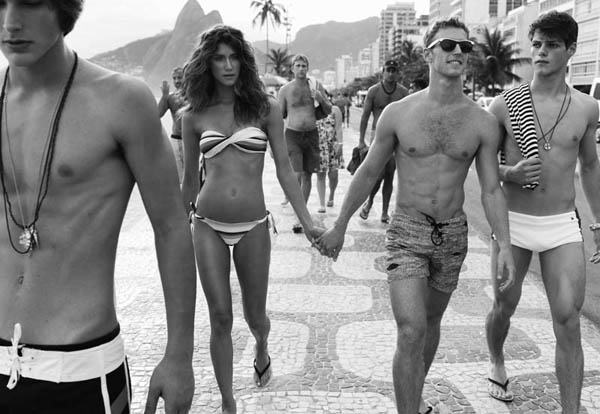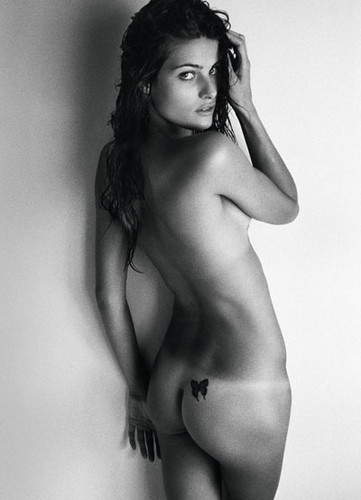
IN ORDER TO DEFINE fashion, theorists have assumed a sharp distinction between the ‘Modern’, the ‘West’, and the so-called ‘pre-Modern’, or primitive (other cultures).1 The Modern is often characterised by active, changing, individual and civilised fashion systems, with the pre-Modern being viewed as more passive, traditional, collective and uncivilised. This Western imperialist construction infers that ‘other cultures’ are in opposition to this dominant fashion system, as widely visualised within fashion photography; in fashion spreads ‘exotic’ people are often shown as a contrast to a more ‘civilised’ model-as-tourist archetype. But, is it possible to challenge this geographical dichotomy? Is there a space between the construction of fashion and its otherness? Fashion photographer Mario Testino implicitly investigates these questions in his book Mario de Janeiro Testino (2009) by exploring the myth of the exotic, undressed bodies performed by contemporary Brazilian fashion icons.2
In his book, Testino depicts the spirit of the Cariocas – the citizens of Rio – through snap-shots of their undressed bodies. They are exposed in various siesta-time situations: a woman casually posing in a hanging chair, a couple kissing sensually outside a house, or a muscular man on the beach. The presentation of nakedness in non-Western cultures in South America is rooted in the late fifteenth century period of colonialisation; the meeting between European and indigenous cultures, where the conquerors saw the nakedness of the local people as a visual sign of primitive inferiority. As literature scholar Mariselle Meléndez describes: ‘For Europeans, moral and physical nakedness justified their presence in foreign lands as fully civilized clothed men. They were “to dress” the Amerindians in a literal and figurative manner, covering their bodies and their souls with fabric, religion, and reason’.3 Fashion and dress began functioning as a symbol of civilised power, and suppressed sexual impulses concerning nakedness were projected on to foreign bodies from the ‘discovered’ world.
The images featuring the models Gisele Bündchen and Carlos Bockelman as playfully intimate and in various states of undress seem to reinforce the much worn cliché about sexually liberated Brazilians and it is tempting to suggest that these Brazilians are participating in their own self-exotification in an effort to live up to the hackneyed image of Brazilian culture established in the West.4 Yet, the liberation of bodies and ‘being seen’ at the Brazilian seaside also holds broader political and social meaning. In Brazilian beach-culture, the seaside is deemed as a ‘free territory’, where people can participate in a liberated lifestyle5 without social prejudice. There is also a broader cultural and political symbolism of nakedness in this context, as a result of the military dictatorship in the area between 1965-84, undressed bodies visually rejected these religious and political restrictions. Hence Testino’s images also celebrate the arguably emancipating mentality surrounding Rio’s beaches.

The bodies in Testino’s book seem to fusion a sharp racial and ethnic contrast: while his photographic gaze is looking at the myth that surrounds tropical bodies, it is also operated within dominant Western codes of fashion. The blue-eyed Gisele embodies the hybrid look with her tanned, conspicuously shaped behind and her curly, honey-blond hair. This hybridisation of ideals maintains the aesthetic cues for the Western fashion system to engage with. Gisele’s sexiness is significant in the image that draws attention to her pelvis, magnetically laying on top of Carlos and covered in a bikini with bright-red erotic signal value. The focus on her buttocks marks her ethnicity and places her within the terrain of Latina body icons, such as Jennifer Lopez, whose ‘booty’ also has been visually cultivated as an exotic fetish.67
Although the Brazilian models are performing an ‘exotic’ identity at the periphery of white norms, they are also included as highly perfect bodies, following the Western ideals. They are neither too dark, too small nor too curvy. The majority has a ‘Latin look’, with brown eyes, black hair and brown skin, but with more Western face and body features. Several have bikini tan-lines as normative ‘fashion stamps’, a contrast that indicates that they in reality are ‘whiter’. Tanning, which became popular in the West in the twentieth century, indicates the power of being a modern fashion chameleon, highlighting the importance of the appropriation of these romantic associations connected to the foreign ‘other’, such as harmony with nature and body instincts. As film scholar Richard Dyer states: ‘[…] the point about tanning is that the white person never does become black not […] only does he or she retain the signs of whiteness […], not only does tanning bespeak a wealth and life style largely at white people’s disposition, but it also displays white people’s right to be various, literally to incorporate into themselves features of other peoples.’8 The reproduction of ‘white’ features mixed with indigenous and Iberian looks, further highlights how Brazil, contrary to other Latin American countries, historically has looked at cross-racial reproduction from an optimistic point of view.
Testino’s photographs explore the ambiguous space of identity between the cultural oppositions of fashion, but the real question seems to be whether it is a fundamental destabilisation of these sharply divided categories of Western fashion and its sub-ordinary ‘other’? Dyer argues that the post-modern idea of multiculturalism as a crucial disruption of traditional identity categories, such as race and class, is a misapprehension. Rather, this hybridity should be understood as not yet being fully explored hindered as it is by white dominance. 9 The limitations of this unfolded postcolonial hybrid resistance, and the continuous existence of stable categories are important if situating Testino’s book in a broader context. While the cultural amalgamation of these Brazilian bodies blurs the sharp distinction of modern vs. primitive, it also reinforces the binary, pushing the ‘other’ even further out in the periphery of what is considered fashion.10
All images by Mario Testino for Mario De Janeiro Testino, published by Taschen, 2009.
Julie Vidal is a writer and academic in fashion studies and art history.
Julie Valqui Vidal, ‘Fashion and its otherness: The representation of Peru in Mario Testino’s High Fashion Photography’, in Catwalk: The Journal of Fashion, Beauty, and Style, Vol. 1: 1 (2012), 45-63. ↩
Mario Testino, Mario de Janeiro Testino (Cologne: Taschen, 2009). ↩
Mariselle Meléndez, ’Visualizing Difference: The rhetoric of Clothing in Colonial Spanish America’, in The Latin American Fashion Reader, ed. Regina A. Root (Oxford/New York: Berg, 2005), 18. ↩
Edward W. Said, Orientalism (New York: Vintage, 2004), 325. ↩
Nizia Villaça. ‘As She Walks to the Sea: A Semiology of Rio de Janeiro’, in The Latin American Fashion Reader, ed. Regina A. Root (Oxford/New York: Berg, 2005), 188-197. ↩
Isabel Molina Guzmán and Angharad N. Valdivia, ’Brain, Brow, and Booty: Latina Iconicity in U.S. Popular Culture’, in The Communication Review 7 (2004), 205-221. ↩
Angharad Valdivia ’Is Penélope to J.Lo as culture is to nature? Eurocentric approaches to ‘Latin’ beauties’, in From bananas to buttocks: the Latina body in popular film and culture, edited by Myra Mendible, 129-138 (Austin: University of Texas Press, 2007). ↩
Dyer, White, 49. ↩
Ibid, 4. ↩
Shane T. Moreman ‘Hybrid Performativity, South and North of the Border: Entre la teoria y la materialidad de hibridación’, in Latina/o Communication Studies Today, edited by Angharad N. Valdivia, 105 (New York: Peter Lang Publishing, 2008). ↩

